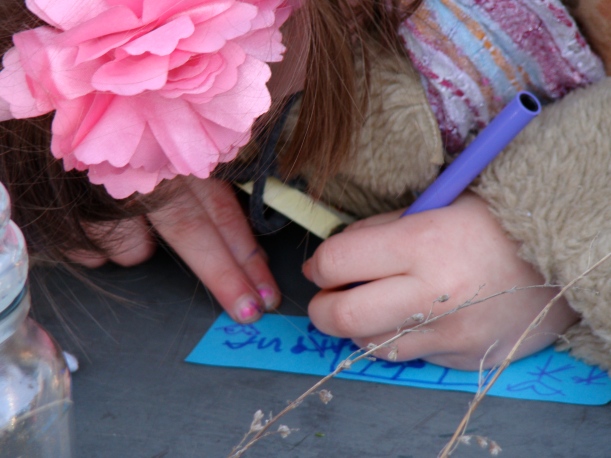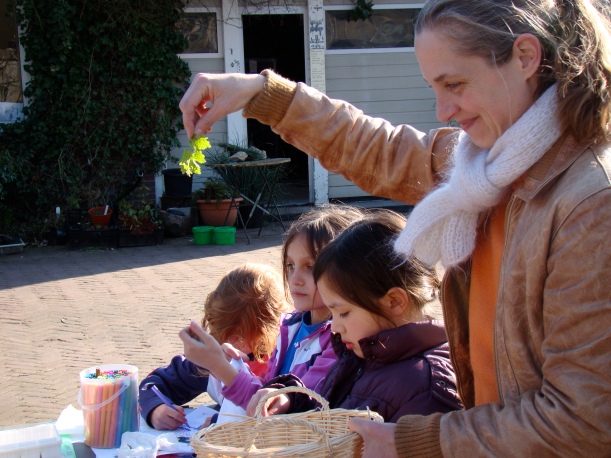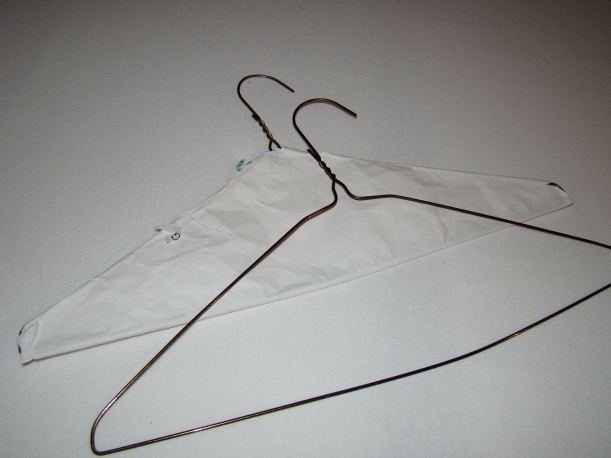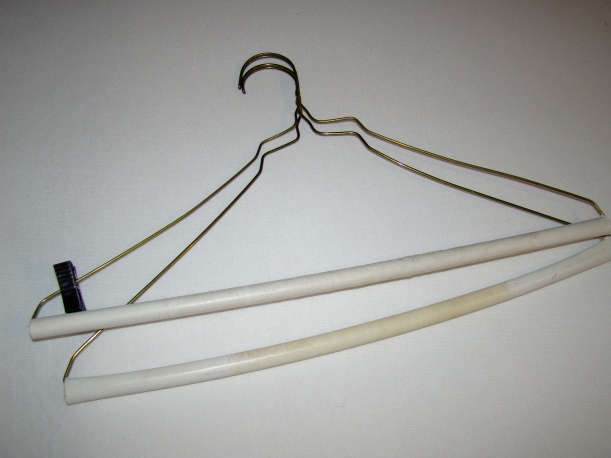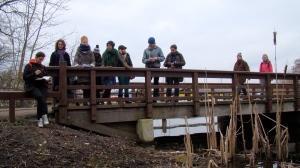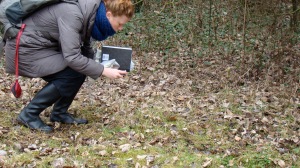When I see young people moodily pulling leaves off a tree as they walk by, or tearing a flower to bits, what I see is an instinctual – though unconcious – act of herbal self-healing. Just as we clench our fists when angry (this is a hand-mudra, used in yoga to deal with anger) or bang our fists to our heads with frustration over a problem (in yoga, pressure on the forehead activates the frontal lobe, dealing with short-term memory and problem-solving), so tearing up leaves or flowers releases chemical components of the plant and surround the person with its healing energy. These are simply my thoughts and intuitions… how do YOU feel about this?
Tag Archives: healing
The Mysterious Cedar – or Cypress?
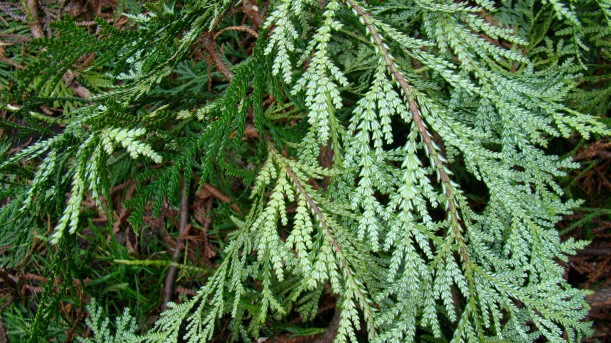
Here’s a tricky fellow. We saw some folks out in their garden today, in their volkstuinhuis (garden lot/house) while we were looking around. They were busy tidying up and pruning some bushes. I was caught by the cedar-scent, and came over to investigate. The photo shows what we found. But I can’t seem to identify it – I thought it was a cedar, but looking it up, I can only think it must be some kind of cypress. If you have any ideas, please help me out. The photo shows both the front and back sides of the flat branches. It is too early for any cones, though had I been thinking, I’d have asked the owners to describe them. Anyway, I kept a bag of it to use – perhaps in tea, perhaps a smudge stick, maybe to flavour our rice tonight… we’ll see. It has a delicious, pungent scent that reminds me of the anti-bacterial properties held in cedars, pines, and cypresses.
Burdock Root

Digging up wild roots in many parts of Great Britain, Europe, and North America is against the law. One must get special permission from park authorities or the land-owner, unless you are digging on your own property. This is an ethical question I sometimes struggle with: in the case when a plant is considered a nuisance, a common weed, wouldn’t it be better for a forager like myself to remove this plant and make good use of it? As opposed to prevelant ‘weed management’, where the plant is removed anyway, and often with harmful pesticides? I know of numerous instances where I respected the law, only to see that the roots I’d have loved to harvest had been dug up en masse by park authorities…
I do understand that we also can’t have everyone digging up as many roots as they like!
Pretty tricky.
Anyway, the delicious burdock roots shown in this photo came from just down the street, from the Korean “Toko” shop; where gobo (its Asian name) is sold for use in traditional Korean and Japanese dishes. If you’ve eaten vegetarian maki, you’ve probably eaten gobo (牛蒡 or ごぼう). Korean use the term “u-eong” (우엉) or “tong u-eong” (통우엉), meaning, “whole burdock”. If you have never tried this before, head over to your local shop and pick some up.
The cultivated roots of burdock can grow about one metre long and two centimetres across, though I believe the wild, first-year burdock would have more medicinal properties than a cultivated one. Burdock root is crisp with a sweet, mild, and pungent flavour and earthy smell. Its helpful to soak it, julienned or shredded, in water for five to ten minutes to keep it from turning grayish-brown once the outer layer has been removed (remove it as one would peel a carrot).
In macrobiotic cooking, burdock root is considered healing, warming, and calming. It helps one think more clearly and stay even-tempered. It is an excellent jet-lag remedy.
Burdock Root (Articum lappa) is great added to soups, stews, and stir-fries. I add it to my ‘almost-famous’ Boston Baked Beans dish. I will post this recipe at a later date and link it to this page. I’ll also continue to add photos of burdock in various stages of growth to help you locate your own; as well as describe all the other amazing things burdock has to offer.
Related articles
- Sweet Potato Ginger Carrot Stew (cookingintuitive.com)
- an Herbalist’s Root Beer (northhollowbotanicals.wordpress.com)

This gallery contains 0 photos
Last week to catch the Dog-Violet

This is probably the last week or two to spy the shy, but fairly common, Dog Violet, viola riviniana. This pretty little flower with the inspiring aroma and gentle, loving energy is full of vitamins – a welcome treat in the old days for families emerging from a winter living off dried and preserved foods.
You may have seen sugared violets gracing fancy cakes and pastries – a few flower-heads in a dried tea mix, or atop a fresh, foraged salad, look simply beautiful. The leaves are also edible.
I suggest, if you see this darling, to just have a nibble of a leaf, followed by the taste of one flower, allowing the scent and flavour to linger on your tongue… unless, of course, you’ve found a forest-edge or shady glen full of them, where if you pick just a few more it should be okay. Maybe a prayer or song for the Dog-Violet faery is in order in that case… 🙂
Herbal Sleep & Dream Pillows for Wild Weed Kids


Dream and Sleep Pillows usually give off a wonderful aroma of sweet and pungent herbs, such as lavender, cedar, chamomile, rose, and anise. Some of the other herbs are not quite so aromatic, but still offer benefits to sleep and dreaming – motherwort and hops. Max (aged 6) is getting a good dose of some Rosemary from her basket! To learn about how to make your own Sleep or Dream Pillow, click here.

We all put special notes, words and/or drawings into our pillows to personalize them and fill them with intent. The children LOVED this concept, and dove into the task of carefully customizing their pillow. Here is 5-year-old Anika with her drawing.

In the bottle you can see dried hops (sleep enhancer), in the background is a bottle of Calendula (gentle, loving dreams) and the loose, dried herb is mugwort (enhanced dreams). Children don’t really need this herb to enhance dreams, but I found such a nice patch, that had been out all winter, and was therefore less potent, I thought it would be nice to introduce it. Plus, it is great for kids to see the herb on the stalk, and pull the dried leaves of themselves.
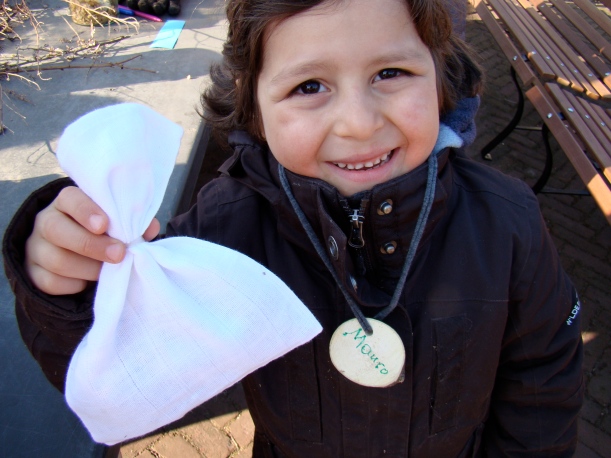
There was some Motherwort (Cardiaca leonorus) growing on-site, and I also had some dried with me… I explained to the children how, aside from the traditional use as a heart-remedy, Motherwort also bathed you in “Mother’s Love” when you felt lonely, angry, jealous, or just plain sad. Or just when you wanted a hug, and your Mommy couldn’t be there. All the kids said they’d like this, especially because they wished they could snuggle with their Mom’s all night long. Marou’s pillow was made with great care, full of all the loving herbs – Motherwort, Rose, Chamomile and Calendula, especially.

We first had a tour of some of the living herbs growing at the VU Hortus – Rosemary, Sage, Motherwort, Cedar, Birch… and then added some extra I provided.
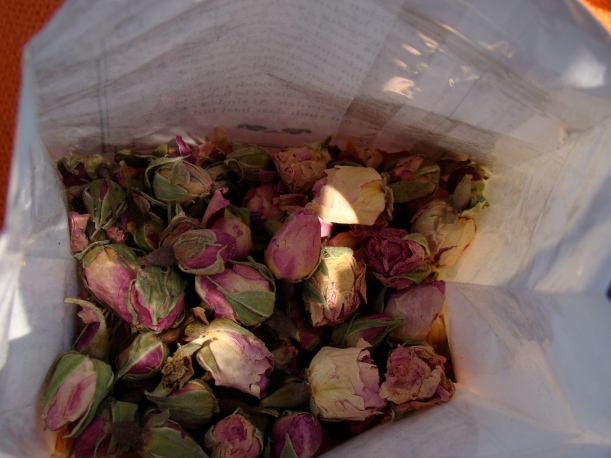
This bag of Rosebuds made each child sigh with happiness, and close their eyes with joy. Can you imagine how they may help with happy, loving dreams? (They also taste divine when added to a pot of black tea)
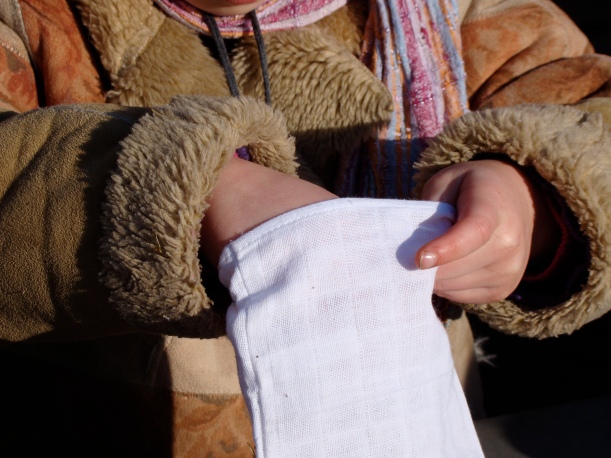
Another good look at the bags (bath-linen mittens) we used. Easy to make yourself as well, with old cloth hankys, for example.
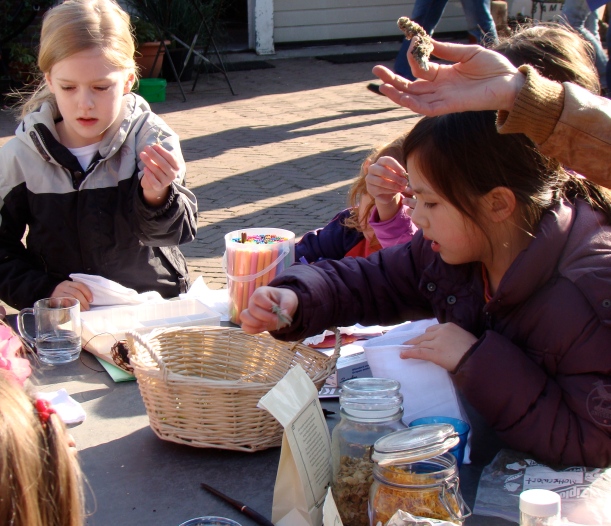
We also added Mullein, to help keep nightmares at bay and have nice dreams. The kids loved the idea of herbs to help with that. Here, I am holding some dried flower-head; there was also some fresh Mullein growing on-site that we discovered and talked about.

The children helped harvest Rosemary leaves and we put them in the pillow – also to ward off bad dreams – and of course, we all ate some!
This gallery contains 39 photos
How to Make L-Rods for Dowsing
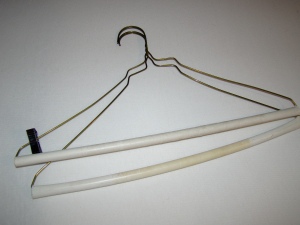
I don’t recall when I first became aware of dowsing, but it was something that happened when I was very young. I heard of people using forked branches to find water, that’s all, and didn’t think about it very much, nor judge whether it was good, bad, or even possible.
When I began studying Feng Shui in Toronto, back in 2000, my teacher, Malca Narrol had suggested dowsing for finding energy problems that couldn’t be explained through regular Feng Shui theory. In her class, we learned how to use a pendulum and how to do muscle testing. I was introduced to the concepts of geopathic stress, Ley lines and energy vortexes. I was enthralled – it was so interesting, and seemed to get results!
In 2002, I studied further, with Gary Skillen, of the Canadian Dowsers Association. Gary taught me about dowsing for personal health, as well as for Tree Energy, using the dowsing rods or our hands. We learned more about Ley lines and how underground streams in certain places in your home (like under your bed) can affect your health and energy. There is abundant information about Ley lines, underground streams, and more, already on the web, so I won’t go into detail about that here. I also studied with renowned dowser, Joey Korn who taught how to find energy vortexes, and how to determine if the vortex was beneficial or detrimental. If it was detrimental, we could change it to be beneficial.
This Sunday, with Wild in the City, we will use L-rods and our hands to locate Tree Energy, beneficial places for planting certain food- or medicine-bearing plants, and perhaps, for finding positive energy vortexes where we can sit for our lunches or to process our wild, homemade herbal tinctures.
There is a lot of controversy over whether dowsing is real or not. I invite you to enjoy whatever opinion you have of it, and, regardless, to give it a try. However, unless you are an experienced dowser and have consistent, reliable results with it, please avoid dowsing for answers to any important questions! We are doing this exercise merely as a means of enhancing our awareness with, and connection to, trees, nature, and Mother Earth.
It is very simple to make your own pendulum or diving rods. Here are instructions on how to make L-rods (metal rods in the shape of an L that can be used to indicate dowsing reactions). This is from Joey Korn’s booklet, “ Dowsing: A Path to Enlightenment”.
To make a pair of L-rods: (Jennie has added photos, see below)
- Get two coat hangers and a wire cutter.
- Cut each hanger just under the hook on one side and at the bottom on hte other side, just before the bend.
- Bend each rod to make an L-shape.
- You can cut plastic straws to use as sleeves, but sleeves are not necessary.
Now you have a pair of L-rods. You can also make L-rods easily from welding rods, also called braising rods.
Jen’s note: Sometimes dry-cleaners will have thin paper-tubes over hangers that are used for hanging pressed pants; these are ideal to use as sleeves, and can be seen in the photographs provided. Personally, I find it nice to have the sleeves, then the L-rods move independently and are less likely to be influenced by your hand movements, heat, etc. Here are the photos of a pair of L-rods I made this evening:

Snip the wire coat hanger at the two points shown in photo – so that you include one of the corners in your piece. Then bend the wire so that it is at a 90-degree angle.
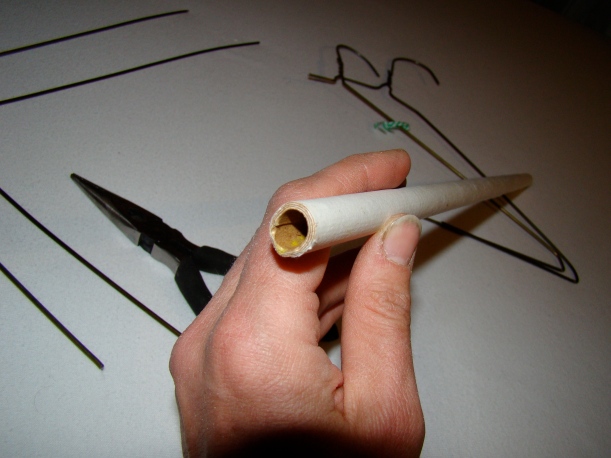
Here’s the tube. You may also have plastic straws, rubber hose, or something else that might be handy to use.
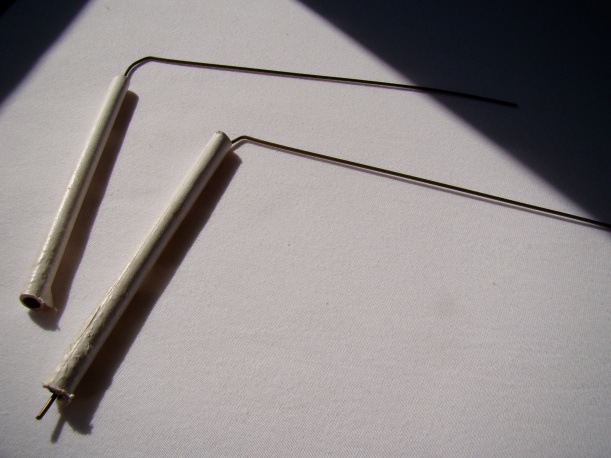
Here are your L-rods! They sure ain’t fancy, but will do the trick. You can spend some cash on pretty ones, or make your own for nothing. That probably took about 5 minutes or so from start to finish. Enjoy!
This gallery contains 5 photos
Wildcrafting

Always a good idea to give resident critters a chance to flee your harvest!
Wildcrafting – gathering plant material from it’s native “wild” environment – is becoming much more popular as an alternative source of food and medicine.
While in many ways nature-based herbal medicines and wild food foraging is ecologically sound – reducing carbon output, reducing chemical use, and, especially, reducing the immense drug-burden (from excreted pharmaceuticals) on soil and water-tables – there is still an impact, especially when there are simply more foragers at large, or if harvesting is done in a non-sensitive manner (trampling plants, pulling then up by the roots, over-harvesting, using endangered plants, simply – not being aware).
Responsible wildcrafting means to ethically harvest those plants which are most prolific and regenerative (dandelion, burdock, cleavers, for example) with the least amount of negative environmental impact.
Many wildcrafters have, or develop, a deep sense of kinship with the plants and surroundings, and make an effort for the protection and sustainability of natural areas. Equally important is an awareness of the ecological and personal relationship between individuals and our sacred Mother, Earth.
If I may, here are few suggestions:
Take the time you need to closely observe your surroundings over the course of days, months and years. That way you’ll know which plants are readily abundant, when they are in harvesting season, and which plants to protect. You’ll also form a respectful, friendly – even loving, relationship with the plants. Allow them to enter into your heart.
Be discreet. Others who witness you plucking plants may go ahead and do the same, but without your awareness and knowledge – especially children, who so love plants but also need some guidance on which are safe to eat, which flowers are abundant for picking, etc.
Know which plants are on the endangered list.
Harvest plants with a sense of respect and gratitude. Do so when in a calm emotional state, so you can stay aware.
Give back to nature in some way, and share your knowledge with other like-minded people. Try to join herbal walks with an experienced guide. Go out on your own, with not one, but two identification books, and look up one or two (or more) selected plants carefully. Touch the plants, smell them, talk to them, listen. If you know the plant is safe to eat, have a nibble. The greater the hands-on experience, the more you’ll remember.
A well-trained wildcrafter will avoid damage or depletion of our natural heritage, and she or he is integral in passing on the herbal knowledge of those who have come before them. If this is you, we need you, and our children need you.
Homemade Herbals

I make most of the family’s medicine, customizing what I feel each member needs. Leah had a lot of congestion and mucus, so her tincture included chickweed, plus burdock for overall health (blood, liver, especially). Anika got burdock and dandelion as a winter tonic. You can see both girls signed their name to the “mother jar” of tincture – they felt pretty special that Mommy was custom-making something for each of them (plus I like the idea of their energy engaged as part of the formula). The teasel root tincture is for me – it is often used for Lyme’s Disease, but I was using it to help repair muscle tissue in my shoulders… which is greatly improved – and a surprise benefit was a better menstruation – non-painful, light flow, short duration (I used to get periods so painful, I’d faint. The flow was heavy and lasted, sometimes, for 10 days.)
I cannot for sure say if this can all be attributed to teasel, or to osteopathy, which I am also receiving. However, a definite improvement is noticed overall, and I’m happy regardless of what caused it. However, if you’ve tried teasel, I’d love to hear back about your experiences with it.
Wild in the City Day One!
Spring Harvest

I like to keep a small paper bag with me in case I see a good, full batch of abundant herbs or edible plants. This photo is from a patch of Coltsfoot flowers, that happened to grow adjacent to a small field full of Violets. We tasted a few Violets, and brought a small sample home for my husband to try – they are considered to be Nature’s Vitamin Pill – and you can imagine how important this would be in earlier times, when people had to survive the winter primarily on preserved food. This sweet little flower is packed with just the vitamins they’d need. Coltsfoot, on the other hand, was traditionally used for sore throats. They’d let it soak in water overnight, and that water was made into a lukewarm – not boiled! – infusion the next morning – to be taken in small doses throughout the day.

